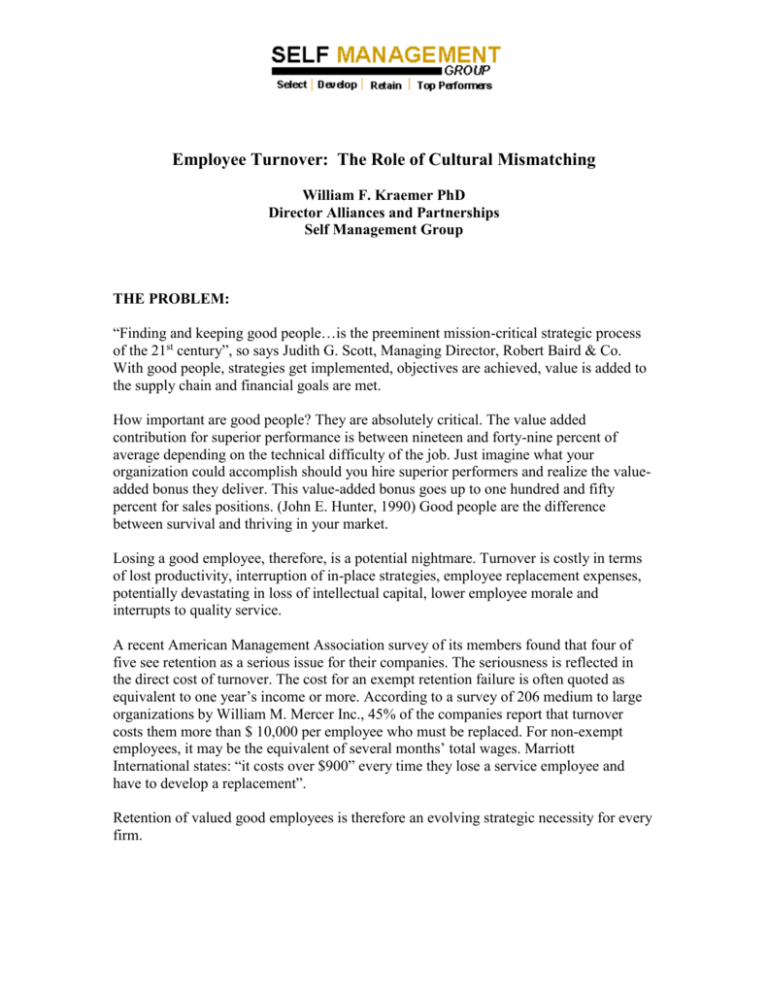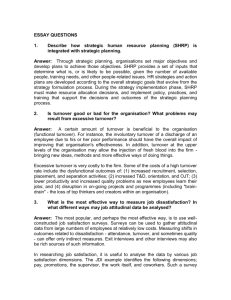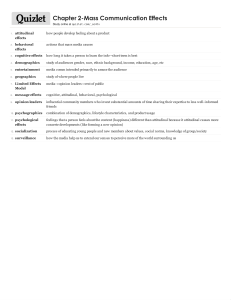cultural matching - Self Management Group
advertisement

Employee Turnover: The Role of Cultural Mismatching William F. Kraemer PhD Director Alliances and Partnerships Self Management Group THE PROBLEM: “Finding and keeping good people…is the preeminent mission-critical strategic process of the 21st century”, so says Judith G. Scott, Managing Director, Robert Baird & Co. With good people, strategies get implemented, objectives are achieved, value is added to the supply chain and financial goals are met. How important are good people? They are absolutely critical. The value added contribution for superior performance is between nineteen and forty-nine percent of average depending on the technical difficulty of the job. Just imagine what your organization could accomplish should you hire superior performers and realize the valueadded bonus they deliver. This value-added bonus goes up to one hundred and fifty percent for sales positions. (John E. Hunter, 1990) Good people are the difference between survival and thriving in your market. Losing a good employee, therefore, is a potential nightmare. Turnover is costly in terms of lost productivity, interruption of in-place strategies, employee replacement expenses, potentially devastating in loss of intellectual capital, lower employee morale and interrupts to quality service. A recent American Management Association survey of its members found that four of five see retention as a serious issue for their companies. The seriousness is reflected in the direct cost of turnover. The cost for an exempt retention failure is often quoted as equivalent to one year’s income or more. According to a survey of 206 medium to large organizations by William M. Mercer Inc., 45% of the companies report that turnover costs them more than $ 10,000 per employee who must be replaced. For non-exempt employees, it may be the equivalent of several months’ total wages. Marriott International states: “it costs over $900” every time they lose a service employee and have to develop a replacement”. Retention of valued good employees is therefore an evolving strategic necessity for every firm. THE CAUSES: The Saratoga Institute (Kevin Dobbs, 2001) reports in a study of 20,000 workers who just left an employer that poor supervisory behavior was the main reason a person quit. In an even larger study by the Gallup Organization involving 2 million workers at 700 companies, the same result was found. The Hudson Institute’s 2000 Global Employee Relationship Report states that the factors that have the highest influence on an employee’s commitment to their workplace include satisfaction with day-to-day activities and care and concern for employees. A 1999 Kepner-Tregoe study reports that two of the top three reasons employees left their organizations were a perceived lack of recognition, and lack of career development. Turnover and retention are not simply opposites of the same phenomenon. Turnover intention results primarily from job dissatisfaction centered on problems with the manager/employee relationship. Retention, however, is attributed to perceived strength of loyalty interpreted as commitment. Commitment is believed to be the result of a clear and unambiguous congruence of values, interests and aspirations between elements of the organization and employee. (For review, see Tett, Robert P. 1993) Commitment has many levels of focus; the immediate work group, immediate supervision, top management and the more abstract entity, the organization. Work group commitment, however, is not the same as organizational commitment. In fact they are not correlated. It is very possible for a person to develop commitment to one or the other, but not to both at the same time. Tom Casey, talent management leader for a unit of PricewaterhouseCoopers identifies six reasons why people commit to an organization. List 1: Top 4 Commitment Drivers 1. Opportunity to learn 2. Compensation 3. Career Potential 4. Manager Tom Casey, Talent Management Leader for PricewaterhouseCoopers First is opportunity to learn followed in third by career potential and in forth is immediate supervision. Commitment evolves from a growing match between expectation of the employee to be trained, strive toward career opportunities, and be mentored by a valued manager. The critical role of immediate supervision in fostering commitment is demonstrated through Casey’s study wherein 60% of the people say they would be willing to leave a job to follow a good mentor. Commitment may be high to the organization but this may not mediate job dissatisfaction and subsequent intention to terminate if there is a mismatch with the work group, supervisor or even top management. This means that an employee can be strongly committed to the corporation as a whole or in part, yet fostering an ‘intention to terminate’ because of job dissatisfaction with immediate supervision. Such appears to be the case. Most voluntary terminations as shown above occur because of a problem with the manager/employee relationship. Figure 1: TURNOVER Employees Departure Planned Unplanned Avoidable Unavoidable 80% of Turnover due to hiring mistakes Turnover, therefore, is frequently and significantly attributed to managerial actions and behaviors, skills and competencies, lack thereof or mismatch with an employee. John Sullivan, head of San Francisco State University’s department of human resources says: “the best way to retain prized employees…is to get managers to take responsibility for retaining their best people…Managers control over 75% of the reasons why people leave their jobs.” “People do not leave companies. They leave bosses.” Says Career Systems International president, Beverly Kaye. Support for the contribution of management style to turnover intention is demonstrated in List 2. Of the eight reasons employees terminate, six are the direct responsibility of immediate management. Obviously, a manger possessing poor supervisory and people skills will have difficulty keeping good employees. But a manager with good technical skills must still be aware of and manage how people are treated on the job, deliver the detail and frequency of communication each individual needs, foster the appropriate amount of challenge, provide continuing growth and development opportunities, recognize contributions and give employees more control over their jobs. List 2: Eight Reasons Employees Terminate 1) 2) 3) 4) 5) 6) 7) 8) Bad Management Practices How People Are Treated On The Job Communication Challenge And Exciting Work Continual Opportunities To Grow And Learn Being Recognized And Rewarded For Performance Having Some Control Over Their Jobs And Life Knowing Their Work Matters John Sullivan, head and professor of human resource management College of Business at San Francisco State University Andy Pearson, prior CEO of PepsiCo, named one of the 10 toughest bosses in America, based on his ability to inflict pain, has found a new way to lead based on personal humility and employee recognition. (David Dorsey, 1991) The newly found secret to his companies competitive advantage is reflected in the realization that: “…the human heart drives a company’s success – one person at a time – and how this kind of success can’t be imposed from the top but must be kindled through attention, awareness, recognition, and reward”. Of the eight reasons employees leave a company, most are a reflection of this newfound observation by Andy Pearson, that today’s management style is the determining factor for minimizing employee dissatisfaction. “Job dissatisfaction is the unhappy emotional state arising from the feeling of compromise of personal values relative to those of the organization and the perceived failure of the organization to meet expectations of emotional conflict resolution”. Rebecca Abraham, 1999 Developing management skills is the only solution to creating an employee specific thriving work culture. To do this requires unique knowledge about us as people, specifically our inherent personality style. Matching of natural or inherent styles is the first step to being able to create supportive and nurturing work environment that compels commitment as well as top performance. BEGIN WITH RECRUITMENT Bill Marriott proclaims, “Retention begins with recruitment.” Successful organizations hire people who fit the job, i.e. are competent, but first and foremost, they hire people who fit the organization by virtue of style, values and work preferences. In other words, they fit the culture of the organization. Hiring people who fit the organization, says Bill Marriott, is mission critical. “It is more important to hire people with the right qualities than with specific experience.” Only a few of the main reasons employees leave a company, independent of the immediate supervision, qualify as a mismatch with the organization. Growth and development opportunities, in example, are typically stipulated by policy. Reimbursements of educational expenses or the opportunity for internal job progressions are governed by policy and therefore establish potential for cultural mismatching. Avoiding these mismatches is clearly easier than mismatches with the manager/employee relationship. Empirical evidence exists to support the role of cultural matching as a requisite for mediation of intention to terminate as well as level of performance. Research examining the consequences of similarities in attitudes and values in work groups has found that supervisor-subordinate attitudinal and value similarity was associated with higher subordinate performance. In fact, evidence exists that perceptions of attitudinal similarity were uniquely and positively related to subordinates’ satisfaction, performance ratings, and pay rating. The importance of attitudinal similarity to manager/employee cohesion cannot be understated. As Marcus Buckingham of the Gallup Organization says; “The corporate world is appalling bad at capitalizing on the strengths of its people…Stop trying to change people. Start trying to help them become more of who they already are.” (Polly LaBarre, 1991) In studying 80,000 managers from 400 companies who excelled at getting great performances from their people, the underlying competency was the ability to help individuals become more of who they are. List 3: Benefits of Attitudinal Similarity 1) Facilitate communication 2) Reduce role conflict 3) Reduce role ambiguity 4) Improved attraction 5) Improved friendship 6) Increased interpersonal interaction Attitudinal similarity has been show to be positively correlated to work group performance through cohesion. (Harrison, David A. 1998) Cohesion, or how well a group works together, is affected by the degree of deep-level diversity. The greater the similarity on deep-level diversity, or attitudinal diversity, the better the work groups perform. Deep-level similarity among group members’ attitudes, belief and values and the positive correlation to work group productivity supports the need for cultural matching between management and employees. CULTURAL MATCHING Culture is loosely defined as the set of norms that drive behavior of people within the organization. There are two components to understanding organization culture. First there is the formal and defined culture of the organization as a whole. The mission, values, policies and procedures of the organization express these. (see List 4) For instance, an outside sales person is motivated by earned commission income. A system designed to pay only salaries would be a poor cultural fit for this employee. Secondly the work group and immediate supervision often establish the informal rules of behavior. Matching employees with the formal culture of the organization is often times a more straightforward process. The key to insuring a good fit is a thorough examination of the requirements of the job and appropriately aligning those with the policies and procedures that govern behavior. It is possible to predetermine the degree of fit by understanding and articulating the governing policies from the outset. List 4: outlines the source for understanding a specific organizational culture. List 4: Organizational Culture 1) 2) 3) 4) 5) 6) 7) Mission Values Policies Procedures Benefits Compensation Work/Family Initiatives The mission statement generally specifies the values of the organization as related to the market, customers, stakeholders and employees. Clearly defined policies and procedures specify the way employees will be treated and interact with the organization. Benefits, compensation plans and work/family initiatives all provide objective evidence of the culture of an organization and provide clear and unambiguous opportunity to assess a potential employees goodness of fit to that culture. Unisys Corporation vice president and chief information officer John Carrow states, "We hear a lot about escalating salaries, lucrative stock options and other material perks as prerequisites for retaining IT employees," says Carrow. "However, that fixation on money minimizes and even trivializes a range of other factors frequently less tangible but no less important – a challenging work environment, opportunities for professional development, responsive and effective management and the sheer satisfaction of participating in a high-performing culture. Matching job candidate attributes, interests and values to organizational cultural characteristics helps minimize the contribution of potential mismatches to unplanned employee turnover. However, these mismatches do not account for the majority of reasons cited for leaving a company. Most causes for unplanned turnover are related directly to the manager-employee relationship. The manager is responsible for achieving the intent and purpose of the organizational culture defined in the content of List 4. CULTURAL MATCHING TO THE MANAGER From exit interviews and other studies previously mentioned, management style and subsequent impact on manager/employee interpersonal relationships predominate as the causative agent for unplanned employee turnover. What are the central issues affecting an employee-manager relationship causing this to be the number one reason employees are retention failures? List 2 identifies seven sources of problems, exclusively under the control of immediate supervision, as to why employees terminate employment. The most important element of ‘fit-to-culture’ is the fit to a manager. A hiring mismatch between a manager and an employee results in both performance and retention failures. We define this ‘fit-to-manager’ as the degree of cultural congruence in style, values and work preferences between the two. List 5: Management Competencies 1) 2) 3) 4) 5) 6) 7) 8) 9) Leadership Style -------Communication Style -Task Orientation -------Implementation Style-Decision Style---------Feedback Approach---Coaching Orientation--People Development -Approach to Learning-- Autocratic to Democratic Factual to people oriented Immediate or relaxed approach to goals Directive or permissive Quick and decisive or methodical Infrequent to continuous and enjoyable Results oriented to accepts modest performance Enjoys to lack of empathy Necessary or automatic Source: Self Management Group, Toronto List 5: identifies nine management competencies for potential mismatch with an employee. A mismatch with any one area alone may not potentiate a retention failure. However, the greater the degrees of cultural mismatch between the employee and manager, the greater the likelihood of retention as well a performance problem in the future. Fortunately, the technology exists to assist in understanding the degree of cultural congruence or mismatch before a relationship becomes established. IMPLICATIONS FOR CULTURAL MATCHING RECRUITING A cultural mismatch between a manager and employee has been demonstrated to be a significant contributor to potential for job dissatisfaction hence intention to terminate and reduced work group cohesion and performance. A logical first step in managing this challenge is cultural matching of the manager/employee relationship early in the recruitment process. Recruiting technologies today extend the opportunity to make this type of determination early in the overall staffing process. The first step is identifying and cataloguing the inherent personality attributes of a manager resulting in their management ‘culture’. Secondly, assessing those same attributes of a potential job applicant during the screening process provides an opportunity for objective determination of the degree-of-fit or degree-of-mismatch early in the process. By screening candidates for the deep-level or attitudinal attributes, matching estimations can be determined at initial contact thereby minimizing screening costs and overhead burden. The beauty of this process is that screening of candidates against know criteria allows for more selective recruitment strategies and minimizes costs of recruitment. SELECTION The outcome of a selection process is the hiring of the best-fit candidate to the job, culture and manager. By quantitative evaluation of candidates against the jobs requisite ‘attitudinal requirements’ essentially represented by the manager, the best fit candidate can be selected. Profiling for attitudinal attributes significantly improves the ability to select the best-fit candidate and strategically improves the organizations performance and retention objectives. Integrated with other selection system components, e.g. structured behavioral interviewing and assessment of fit, it is possible to maximize the opportunity to make the best hiring decisions. DEVELOPMENT Knowing where cultural mismatches exist within a manager/employee relationship, specific and targeted interventions can be created to minimize the impact of that mismatch. For instance, a mismatch between degree of self-management emphasizes the need for such training programs as time management and prioritization planning. BIBLIOGRAPHY Abraham, Rebecca. The Impact of Emotional Dissonance on Organizational Commitment and Intention to Turnover, J of Psychology, 1999, 133(4), 441-455 Kevin Dobbs. Knowing How to keep Your Best and Brightest, Workforce, April 2001, p. 57 David Dorsey. Andy Pearson Finds Love, Fast Company, 1991, August, p. 84 Harrison, David A.; Price, Kenneth H.; et al. Beyond Relational Demography; Time and the Effects of Surface – and Deep-Level Diversity on Work Group Cohesion. Academy of Management Journal, Feb98, Vol. 41 Issue 1, p. 96 Hunter, John E.; Schmidt, Frank L. Individual Differences in Output Variability as a Function of Job Complexity. J. Applied Psychology, 1990, Vol. 75, No. 1, pp. 218-42 Polly LaBarre. Marcus Buckingham Thinks Your Boss Has An Attitude Problem, Fast Company, 1991 August, p. 94 Mahan, Thomas. Turnover Cost. 1998 Human Resource Financial Report. The Saratoga Institute, pp. 295-300, 1998, p. 298. Tett, Robert P.; Meyer, John P. Job Satisfaction, Organizational Commitment, Turnover Intention, and Turnover: Path Analyses Based on meta-Analytic Findings, Personnel Psychology, Summer 93, Vo. 46 Issue 2, P 259, 33p








